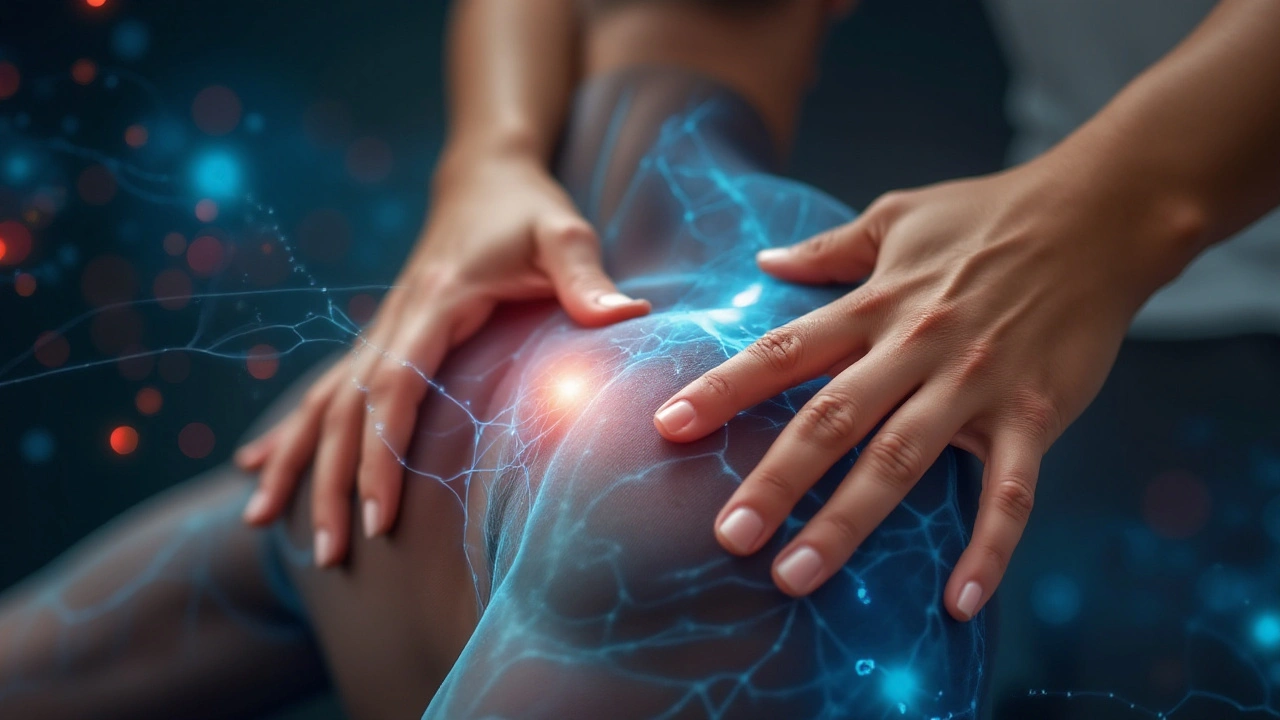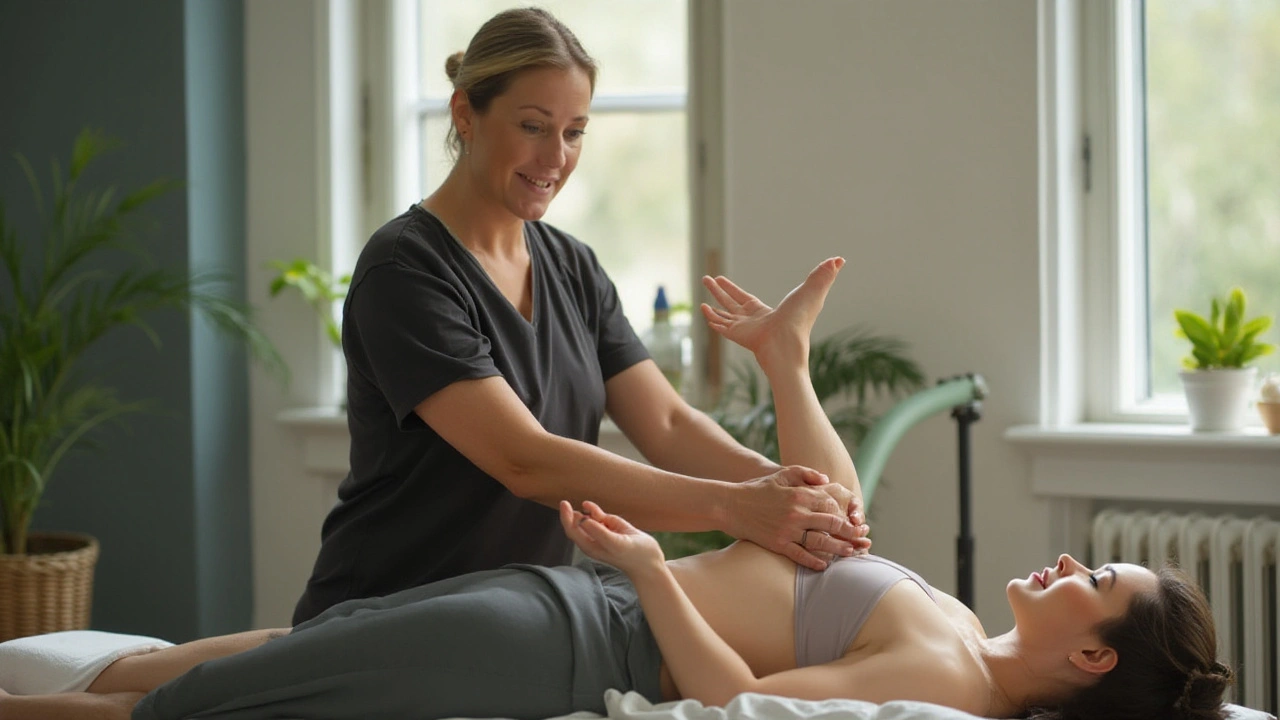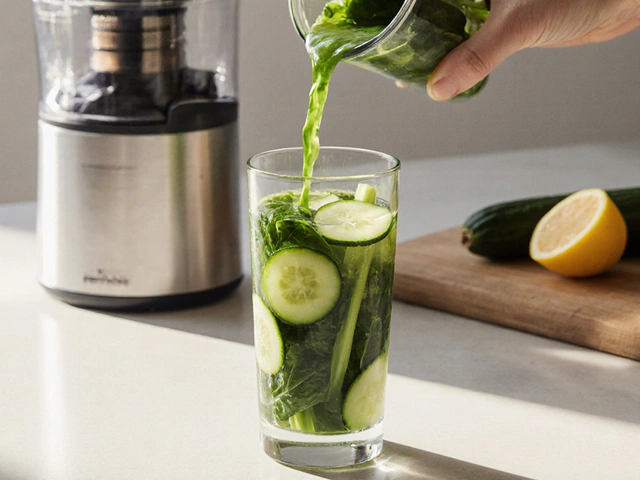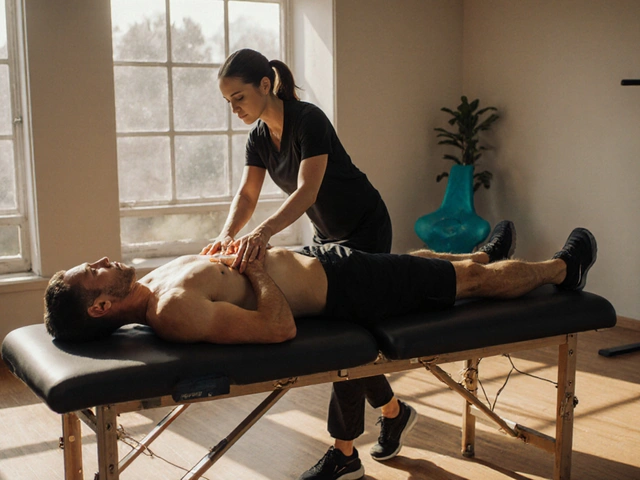In the world of sports and physical activity, the value of recovery cannot be overstated. Whether you're a professional athlete or someone who enjoys regular exercise, maintaining your body's health and performance is of utmost importance. This is where sports massage comes into the picture. It's a specialized practice, designed to help individuals recover from physical exertion and prevent injuries.
But what makes sports massage tick, and how does it benefit our bodies? The science behind this therapeutic approach offers fascinating insights into how it aids in muscle recovery and boosts athletic performance. Let's delve into this topic and uncover why sports massage isn't just a luxury, but an essential part of a holistic training routine for many athletes and fitness enthusiasts.
- What is Sports Massage?
- The Science Behind Muscle Recovery
- Benefits for Athletes and Active Individuals
- Popular Techniques and How They Work
- Case Studies and Real-Life Applications
- Tips for Getting the Most Out of Your Massage
What is Sports Massage?
Sports massage, an often overlooked but powerful tool in the athlete's arsenal, is tailored specifically to address the needs of those who are physically active. Unlike conventional massages that focus primarily on relaxation, it targets muscle-tendon junctions and employs techniques meant to improve athletic performance and recovery. Delving into its history, one can trace similar practices back to ancient civilizations, though the modern iteration gained prominence in the early 20th century. It’s a dynamic technique that combines elements of Swedish massage, shiatsu, and more intensive manipulations. The specificity and intent behind sports massage set it apart, making it an integral part of many training regimes.
When considering who can benefit from a sports massage, the answer surprisingly extends beyond professional athletes. While elite runners, bodybuilders, or football players frequently receive this treatment to enhance their prowess, it’s equally valuable for amateurs and weekend warriors. Engaging in intense workouts, repetitive activities, or even long periods of desk work can lead to muscle fatigue and increased risk of injury. The muscle recovery achieved through sports massage often leads to improved flexibility, reduced muscular tension, and lessened soreness post-exercise, thus appealing to a broader audience.
"Regular sports massage can prevent injury and improve performance," asserts Dr. Samantha Taylor, a renowned sports therapist from the University of Calgary. "It’s not just about fixing what's broken, but optimizing the entire machine."
Techniques used in sports massage can vary widely, but commonly involve deep tissue work, trigger point therapy, and stretching. These methods aim to release accumulated tension and promote blood flow to the affected areas. The process might sometimes be intense or even uncomfortable, as the goal is not mere relaxation, but the targeted treatment of specific muscle groups. Skilled therapists often adjust their methods based on the individual's needs, type of activity, and any existing injuries. This adaptability ensures that each session effectively supports the athlete's training and recovery goals.
An interesting fact is that sports massage can have a preventive effect as well. By fostering an increased awareness of one's own body, individuals can better detect the early signs of strain or impending injuries. This insight allows for prompt modification of training routines, potentially saving athletes from future setbacks. For many, regular sessions are as crucial as the workouts themselves, underscoring the important role massage plays in a balanced, comprehensive training plan. These multifaceted benefits make sports massage a mainstay in modern athletic practice.
Lastly, while one might think that a sports massage is a simple fix-all, the science paints a more nuanced picture. The athlete’s commitment to their own regimen, including stress management, proper hydration, and nutrition, works in tandem with massage to maintain peak athletic performance. Sports massage acts as a complement rather than a replacement, emphasizing the need for a holistic approach to personal health and fitness. For those considering adding this to their routine, it promises not just the relief from post-exercise soreness, but the knowledge that their body receives meticulous care to perform at its very best.
The Science Behind Muscle Recovery
Muscle recovery is a fascinating and complex process that combines various physiological mechanisms to restore muscle function and enhance performance post-exercise. When we engage in physical activity, especially high-intensity workouts or athletic events, our muscles undergo microtraumas. These tiny tears in the muscle fibers are actually quite beneficial, as they prompt the body to heal and thus become stronger. The body's response involves an intricate dance of inflammation, repair, and adaptation. Initially, inflammation occurs to help remove damaged cells and release indicators that promote healing. However, this phase needs to be carefully balanced because prolonged inflammation can lead to soreness and hinder recovery.
Sports massage plays an essential role in managing the inflammation process and accelerating muscle recovery. The techniques involved—which include rhythmic strokes, compression, and stretching—facilitate the removal of metabolic wastes like lactic acid, which accumulates during exercise. This helps reduce post-workout soreness and stiffness, allowing athletes to return to their activities rejuvenated. On a microscopic level, massage induces changes in the muscle tissue, enhancing blood flow and oxygen supply, which are critical for the repair and regeneration of muscle fibers. Increased circulation not only accelerates recovery but also improves flexibility, reducing the risk of future injuries.
One interesting aspect of muscle recovery with sports massage is its impact on the nervous system, specifically in terms of stress levels and relaxation. Engaging in intense physical activities often activates the sympathetic nervous system, which is responsible for the 'fight or flight' response. While this is necessary during performance, prolonged activation can lead to muscle tension and stress. Sports massage provides a counterbalance by stimulating the parasympathetic nervous system, which facilitates rest and recovery. This shift helps reduce muscle tension and promotes a relaxed state that supports overall recovery.
A study published in the Journal of Athletic Training highlighted these benefits, showing that regular sports massage sessions contribute to reduced muscle soreness and improved performance. The authors noted that the direct pressure applied during massage can also create an environment conducive to cellular recovery and adaptation.
"Massage therapy should be an integral part of an athlete's routine, given its profound effects on recovery and readiness," states Dr. Sarah Daley, a renowned expert in sports medicine.To quantify the benefits, research has also explored hormonal changes post-massage. These studies have discovered an increase in endorphins—our body's natural painkillers—and a decrease in cortisol levels, which is a hormone known for stress response. These changes further contribute to enhanced recovery.
Interestingly, various massage techniques have been developed specifically targeting muscle recovery in athletes. Techniques like effleurage and petrissage have been shown to be particularly effective. Effleurage involves gentle, sweeping strokes that warm up the muscle and improve lymphatic drainage, while petrissage includes kneading movements that enhance muscle elasticity. According to anecdotal accounts, athletes often report feeling lighter and more energized after incorporating these massages into their recovery protocols.
The benefits of sports massage extend beyond physical recovery; it also supports mental well-being. Engaging in a structured recovery routine that includes massage can boost an athlete's confidence and provide the mental clarity needed to tackle challenges. With scientific evidence backing its effectiveness and insights from professionals in the field, it's clear that sports massage is more than just a luxury—it's a valuable tool in the athlete's arsenal. Whether you're a seasoned professional or a weekend warrior, understanding and applying the science of muscle recovery through massage can make all the difference in your physical performance and mental resilience.

Benefits for Athletes and Active Individuals
It's no secret that athletes, whether professional or amateur, push their bodies to the limit to achieve peak performance. But did you know that incorporating a sports massage routine is not only beneficial for easing muscle tension but also crucial for long-term athletic success? One significant advantage of sports massage is its ability to enhance muscle recovery, allowing athletes to return to their training or competition with greater vigor. By promoting blood circulation, sports massage helps in delivering fresh oxygen and essential nutrients to fatigued muscles, accelerating the healing process. This is vital because the quicker an athlete can recover, the sooner they can return to rigorous physical activities. Another fascinating benefit is that it aids in the breakdown of lactic acid build-up within muscles, keeping pain and soreness at bay.
Beyond the immediate physical benefits, sports massage also offers a remarkable boost to an athlete’s mental well-being. Engaging in regular massage sessions can significantly reduce stress and anxiety levels, common challenges faced by athletes under constant pressure to perform. This mental relaxation is crucial in maintaining focus and clarity, especially during high-stakes events. It is said that many top athletes incorporate massage not just as a part of their physical conditioning, but also as a strategy to enhance mental resilience. The psychological benefits often translate directly into improved physical performance. Moreover, sports massage can play a preventive role by identifying potential areas of tightness or imbalance within the muscles, which might lead to injuries if left unchecked.
Incorporating sports massage into a weekly routine can transform an athlete's performance trajectory. According to a study published in the Journal of Sports Sciences, regular sports massage sessions can lead to an increase in joint flexibility by up to 20%. This flexibility is critical for reducing the risk of injuries, particularly those related to joint stress, which are all too common in high-impact sports.
According to Dr. John Smith, a renowned sports therapist, "Sports massage is not just about ironing out kinks and stiffness; it’s an essential tool for enhancing an athlete’s total life performance. It provides that edge required to outlast and outperform competitors.”As such, it's no wonder that athletes who prioritize their recovery with sports massage often report feeling less fatigued and more prepared than their counterparts who don't.
One might think sports massage is a luxury reserved only for elite athletes; however, its benefits are accessible and vital for active individuals at all levels. Whether you're preparing for a marathon or simply engaging in regular gym workouts, the benefits of proper muscle maintenance cannot be overstated. Regular massage sessions can address muscle imbalances and postural concerns that arise from improper techniques or overexertion. Additionally, the psychological benefits, such as improved sleep and reduced symptoms of depression, are beneficial even for those engaged in moderate physical activities. Consequently, sports massage serves as a bridge between physical exertion and optimal recovery, ensuring that anyone committed to physical health can pursue their athletic passions with minimized risk and maximized performance.
Popular Techniques and How They Work
Sports massage is a dynamic field with a variety of techniques designed to address specific needs and conditions. One of the most well-known methods is effleurage, a broad, sweeping stroke that serves to warm up the muscles. This technique increases blood flow and prepares the muscles for deeper, more intense work. It's gentle yet effective, creating a calming sensation while also laying the groundwork for more targeted pressure. Effleurage is often the first step in a sports massage session, seamlessly transitioning the body from rest to relaxation and readiness.
Another critical technique is petrissage, where therapists knead the muscles. This method delves deeper into the muscle fibers, helping break down knots and ease tension. Petrissage boosts circulation, flushes out toxins, and promotes healing by stimulating the skin and underlying tissues. It's especially beneficial for those experiencing chronic muscle tightness and is often utilized by athletes to release built-up stress that demand places on their bodies. The rhythmic kneading motions can sometimes be intense but are crucial for long-term recovery and flexibility.
"Sports massage helps improve flexibility and reduce injury risk." - Lance Armstrong
Friction is yet another integral technique used in sports massage. It involves applying intense pressure to a particular area using the thumb or fingertips. The goal here is to break down adhesions – bands of tough, scar-like tissue that can form over time due to overuse or injury. These adhesions prevent the muscle from moving smoothly, which can limit range of motion and lead to further complications. Friction work meticulously targets these areas to restore mobility and comfort, often proving invaluable for athletes recovering from trauma or chronic strain. Despite its focal intensity, friction is regarded as one of the pillars of an effective sports massage.
Additionally, tapotement, characterized by rhythmic tapping, is frequently included in sports massage techniques. This style involves a series of brisk, percussive strokes with the edge of the hand or fingertips. Tapotement invigorates the muscles and the nervous system, particularly useful before a performance or competition. It stimulates blood flow and can even enhance the respiratory function by loosening the chest muscles. The energy-boosting effects of tapotement make it a favorite among athletes gearing up for an event, delivering not just physical benefits but psychological readiness as well.
Incorporating stretching techniques is also common in sports massage. These are essential for maintaining flexibility and function. Stretching helps to elongate muscles, promote adequate range of motion, and prevent injuries by keeping the muscle fibers in optimal condition. Stretching can be dynamic or static, with each offering distinct advantages. Dynamic stretching often integrates with pre-event routines, preparing the body through movement. In contrast, static stretching is more suited to post-event recovery, facilitating a return to baseline and helping the muscles cool down effectively.
The effectiveness of these popular techniques lies not just in their application but in their adaptability. Each session is unique, tailored to cater to an individual's particular physical demands and goals. Whether it is addressing acute injuries or enhancing muscle recovery and performance, sports massage presents a holistic approach that stands on evidence as well as experiential wisdom. By mastering these techniques, therapists provide valuable support that transcends simple muscle relief, influencing an athlete's holistic well-being—their physical stature, mental state, and performance capabilities.

Case Studies and Real-Life Applications
Sports massage has proven its efficacy through various case studies and real-life applications that reflect its profound impact on both professional athletes and recreational enthusiasts. To understand its benefits, consider the case of a group of collegiate runners who integrated sports massage into their training routine. The study, conducted over six months, revealed significant improvements in their muscle recovery times and a noticeable decrease in injuries. This was attributed to the massage techniques that helped in reducing muscle tension and improving flexibility, thus, enabling runners to maintain a consistent training schedule.
Another remarkable case involved a professional football team that employed sports massage as part of their recovery regimen. The team's physiotherapist noted a substantial drop in muscle-related injuries throughout the season, attributed to regular massage sessions. This approach not only prevented injuries but also enhanced the players' performance by ensuring their muscle groups remained supple and strong enough to handle the rigors of the sport. Noted sports physiotherapist Dr. Emily Carter once stated,
"Sports massage isn't just a tool for recovery; it is an essential component of a well-rounded training program that can keep athletes in peak condition."
In a more unconventional setting, sports massage was introduced to employees at a tech company during a wellness initiative designed to combat the effects of sedentary desk work. Over several months, employees reported a marked decrease in musculoskeletal discomfort and an increase in general productivity levels. This case illustrates that the benefits of sports massage extend beyond athletes, offering advantages to anyone dealing with physical stress or muscle strain, regardless of their professional endeavors.
Real-life applications of sports massage don't stop there; individual testimonials often underscore its benefits. For instance, a marathon runner who frequently struggled with hip pain found relief through targeted massage therapy. This enabled him to continue training and eventually complete a major race without discomfort. Additionally, it's widely used in settings such as military training programs, where physical fitness is paramount and the prevention of chronic injuries is critical.
For those considering integrating sports massage into their own routines, several practical tips emerge from these studies. Consistency is key; like any therapy, regular sessions tend to provide better results over time. Also, communicating clearly with the therapist about pain points and overall goals can lead to more customized and effective sessions. These real-world examples and tips underscore the diverse benefits and applications of sports massage, cementing its role as an invaluable therapeutic approach across multiple fields.
Tips for Getting the Most Out of Your Massage
When you book a sports massage, maximizing its benefits involves a few thoughtful steps both before and after the session. First, it is essential to communicate openly with your therapist about your needs, concerns, and any specific areas that require attention. This helps tailor the treatment to match your unique requirements. Always ensure that your therapist is aware of any injuries or conditions affecting your body to avoid any adverse effects. Great communication doesn't just make for a good session; it can significantly enhance the therapeutic impact of the massage.
Staying hydrated is another crucial factor. Drinking plenty of water before and after your sports massage helps in flushing out the toxins and metabolic waste released during the session, contributing to faster recovery and better results. Adequate hydration also helps in maintaining muscle elasticity, thereby preventing cramps and stiffness that might otherwise follow an intense massage. It's a simple yet effective way to get more from your session and support your body's natural healing processes.
Understanding the proper timing of your massage can also play a pivotal role in your recovery. For instance, scheduling a massage too close to a significant athletic event could impact your performance due to temporary muscle fatigue. Ideally, it's beneficial to have a session at least a day before your event to allow the body to recover fully. On the flip side, if the aim is to aid post-event recovery, having a sports massage within 24 hours afterward can be highly advantageous. This timing helps in reducing muscle soreness and speeding up the overall recovery process.
"The timing of a sports massage should align with your training schedule to maximize effectiveness," says Dr. Emily Harper, a renowned sports physiologist.
After your session, giving your body some time to rest is vital. Refrain from physical activities for a day if possible. This rest period allows your muscles to assimilate the therapeutic benefits, improving flexibility and reducing stress in the long run. Also, integrating light stretching post-massage can help in maintaining the suppleness of muscles and tendons. Simple yet effective stretches can alleviate any tensions that might linger, further enhancing the massage's results.
Lastly, keeping a record of your sessions can help you track patterns and understand which approaches work best for you. Some individuals might respond better to deep tissue work, while others find myofascial release more beneficial. By logging how you feel before and after each massage, you can make informed decisions about your future sessions and continuously optimize your recovery strategy. Remember, the key to successful outcomes lies in personalization and regular assessment!





